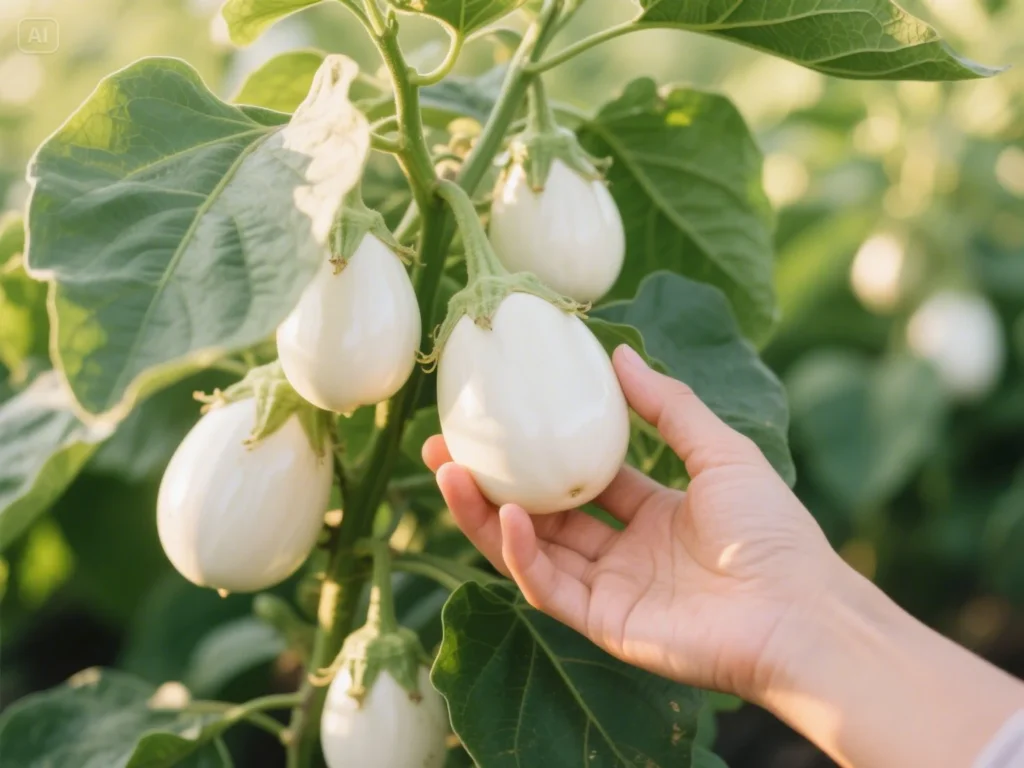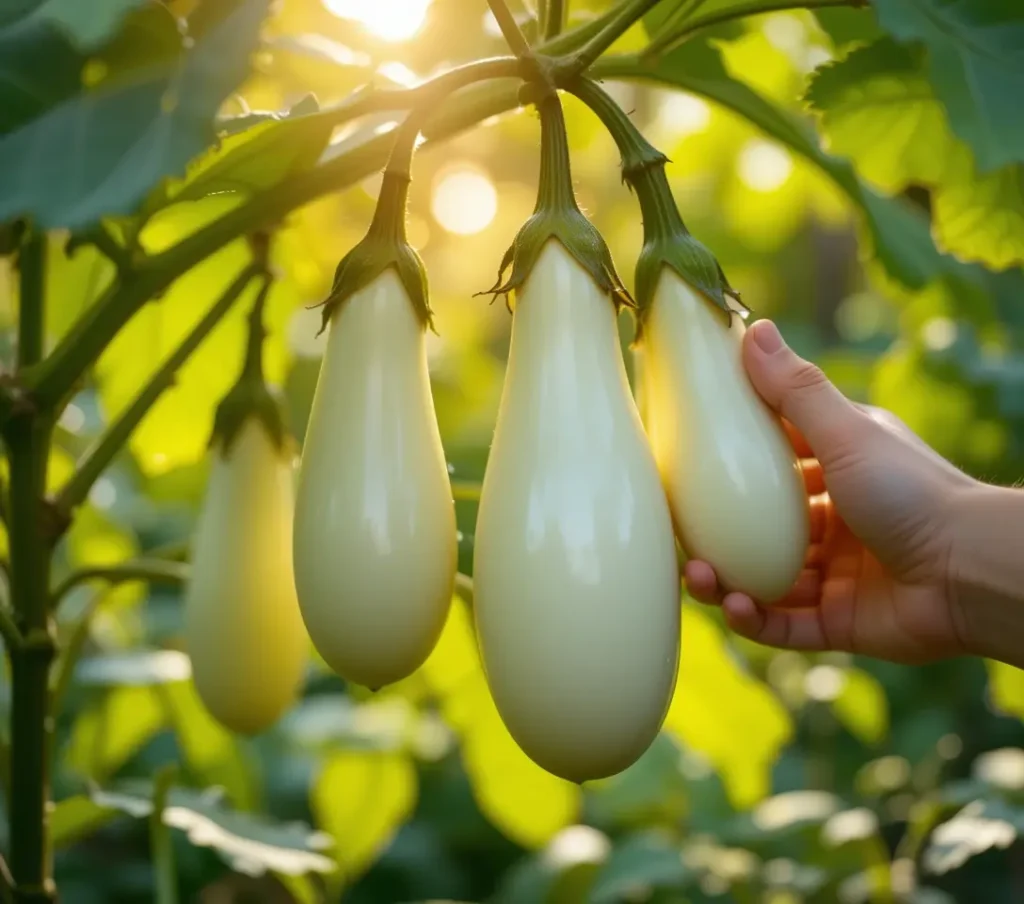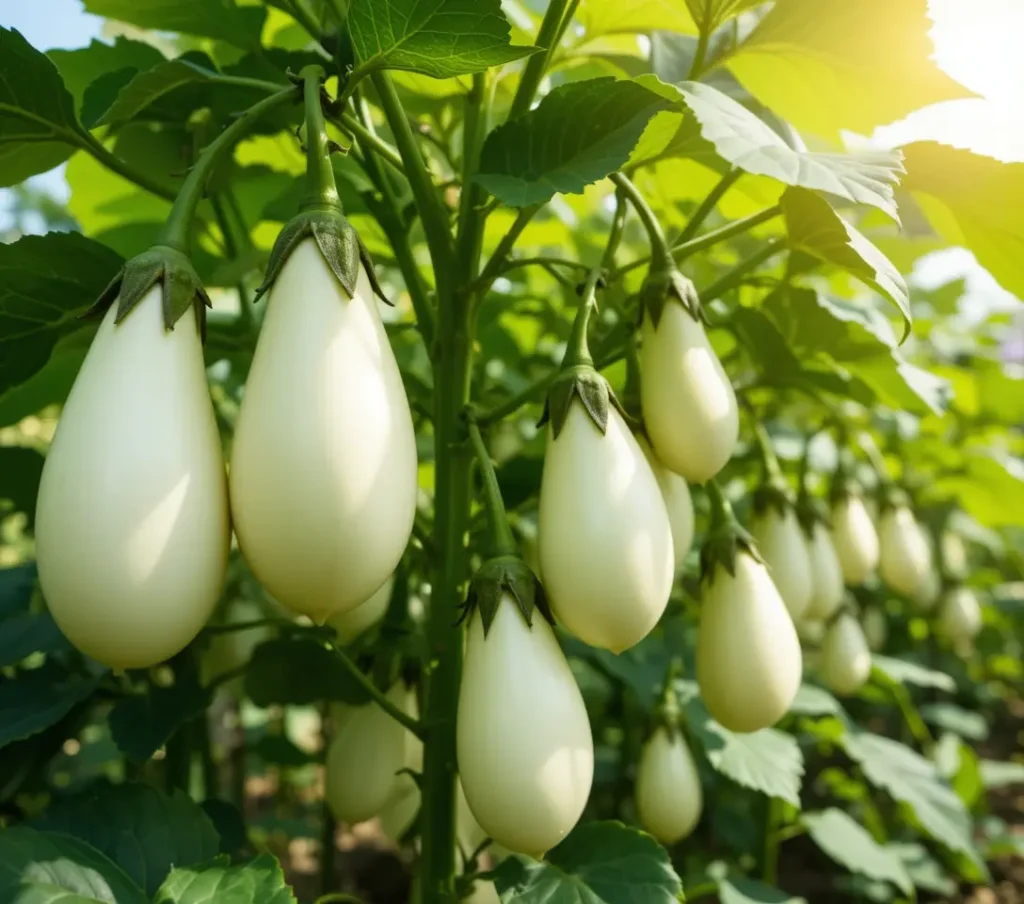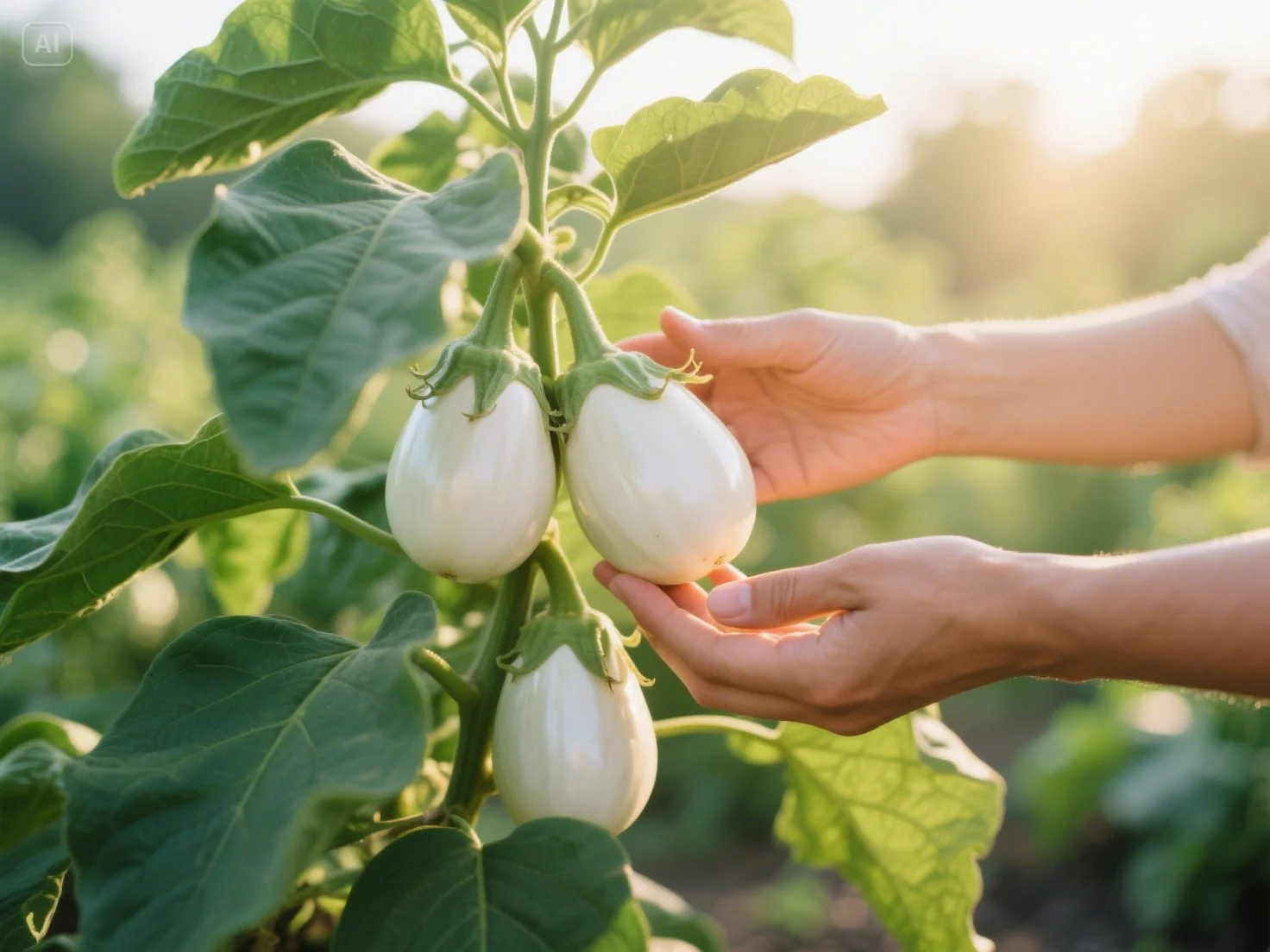Introduction
Think eggplant is always purple? Think again. Meet the white eggplant, a pale, creamy cousin of the familiar purple variety that’s quietly stealing the spotlight in gardens and kitchens. Part of the Solanum melongena family, this veggie isn’t just a novelty. It’s a versatile, nutrient-packed gem that deserves a place on your plate and in your garden.
So, what makes white eggplant different? For starters, its ivory skin lacks the anthocyanins that give purple eggplants their deep hue. This isn’t just about looks. Many gardeners and chefs swear white varieties have a milder, less bitter flavor and a silkier texture. Some even call them the “gateway eggplant” for picky eaters.
In this guide, we’ll explore:
- What defines a white eggplant (hint: it’s more than just color!).
- How does its taste stack up against purple types.
- Top varieties to grow or buy.
- Surprising health perks you won’t want to miss.
- Simple tips for cultivating your own crop.
Whether you’re a curious foodie or a gardener hunting for something new, white eggplant offers a fresh twist on a classic ingredient. Let’s dig in.
What Exactly is White Eggplant?

At first glance, white eggplant might look like a pale imitation of its purple cousin. But this veggie stands out for more than just its color. Genetically, white eggplant (Solanum melongena) shares the same species as purple types but with one key difference: it lacks anthocyanins, the pigments responsible for that classic deep purple hue. Without these compounds, the skin stays creamy white, and some say the flavor becomes milder too.
Appearance: More Than Just a Pretty (Pale) Face
White eggplants come in a range of shapes and sizes:
- Oval: Plump and round, like the popular White Beauty variety.
- Elongated: Slender and curved, perfect for slicing into rounds.
- Round: Golf ball-sized types, ideal for stuffing.
The skin is smooth and glossy, often thinner than purple varieties. This means you might not need to peel it before cooking, a bonus for busy home chefs.
Botanical Notes: Fruit or Vegetable?
Here’s a fun fact: Botanically, white eggplant is a fruit (it grows from a flower and contains seeds). But in the kitchen, it’s treated like a vegetable thanks to its savory flavor. Like tomatoes and peppers, it belongs to the nightshade family. This makes it a cousin to potatoes, too, though it’s less starchy and more versatile in dishes.
Why the Nightshade Family Matters
Nightshades contain alkaloids, which can trigger sensitivities in some people. But don’t worry, white eggplant’s alkaloid levels are low, especially when cooked. Its mild flavor and tender flesh make it a safe bet for most diets.
Ready for the next section? Let’s explore how white eggplant tastes and why it might win over skeptics.
The Taste Test: Does White Eggplant Taste Different?

If you’ve ever hesitated to cook eggplant because of its bitter reputation, white eggplant might change your mind. Let’s settle the big question: How does it taste?
Flavor Profile: Mild and Approachable
White eggplant is often praised for its milder, sweeter flavor compared to purple types. Think of it as the “introvert” of the eggplant world, subtle, not overpowering. While purple varieties can have a slightly bitter edge (especially older cultivars), white eggplant tends to be gentler on the palate. This makes it a hit in dishes where you want the veggie to blend, not dominate, like curries or pasta sauces.
Texture: Creamy Comfort
When cooked, white eggplant transforms into a velvety, melt-in-your-mouth texture. The flesh is less spongy than purple eggplant, so it absorbs sauces and spices without becoming mushy. Roast it, grill it, or sauté it, you’ll get a creamy consistency that works well in dips like baba ganoush or layered in lasagna.
Seeds: Less Is More
Good news for seed-averse cooks: White eggplant usually has fewer and smaller seeds than purple varieties. This means less grit and more smoothness in every bite. The seeds that are present are soft and blend seamlessly into dishes.
Bitterness Factor: Skip the Salt
Here’s a game-changer: You likely don’t need to salt white eggplant before cooking. Purple eggplants sometimes require salting to draw out bitter juices, but white varieties have lower levels of alkaloids (like nicotine) that contribute to bitterness. Modern breeding has reduced these compounds further, making white eggplant a “no-prep-needed” option for quick meals.
Why This Matters
The mild flavor and forgiving texture make white eggplant ideal for:
- Picky eaters or kids who dislike strong veggie tastes.
- Recipes where eggplant plays a supporting role (e.g., stir-fries).
- Raw preparations, like thinly sliced in salads.
Next up: Discover the most popular white eggplant varieties from heirlooms to hybrids. Ready?
Popular White Eggplant Varieties to Know

White eggplant isn’t a one-size-fits-all veggie. From heirlooms passed down for generations to modern hybrids bred for resilience, there’s a variety for every garden and kitchen. Let’s explore five standout types:
Casper
Ghostly white and garden-friendly, Casper is a top pick for beginners.
- Shape: Elongated teardrop (6–8 inches long).
- Flavor: Mild, with a subtle sweetness.
- Why Grow It: High yields and sturdy plants thrive in both containers and garden beds.
- Bonus: Thin skin means no peeling required, perfect for grilling.
Japanese White Egg
Don’t let the name fool you, this isn’t an egg, but it’s just as versatile.
- Shape: Small and oval (3–4 inches), resembling a chicken egg.
- Flavor: Delicate, almost buttery when roasted.
- Why Grow It: Prolific producer; ideal for small spaces or patio pots.
- Bonus: Tender skin holds up well in quick stir-fries.
Cloud Nine
A hybrid workhorse built for reliability.
- Shape: Large and oval (8–10 inches), with smooth, glossy skin.
- Flavor: Balanced, neither bitter nor overly sweet.
- Why Grow It: Strong disease resistance (especially to verticillium wilt).
- Bonus: Fruits stay firm longer after harvest, great for meal preppers.
Gretel
The “snacking eggplant” you didn’t know you needed.
- Shape: Petite and finger-like (4 inches), clusters like grapes.
- Flavor: Sweet, with almost no bitterness.
- Why Grow It: Nearly seedless flesh and early maturity (55 days!).
- Bonus: Harvest whole clusters for eye-catching appetizers.
Icicle
Elegant and slender, this variety is a showstopper.
- Shape: Long and narrow (10–12 inches), like a white zucchini.
- Flavor: Subtle, with a creamy texture.
- Why Grow It: Consistent producer in hot climates.
- Bonus: Uniform slices work beautifully in ratatouille or skewers.
Heirloom vs. Hybrid: What’s the Difference?
- Heirlooms (like Japanese White Egg): Open-pollinated, so you can save seeds year-to-year.
- Hybrids (like Gretel): Bred for traits like disease resistance or compact growth.
Pro Tip: Love unique flavors? Stick with heirlooms. Prioritize pest resistance? Hybrids have your back.
Next, we’ll dive into the science-backed health benefits of white eggplant. Ready?
Growing White Eggplant in Your Garden
Good news: If you’ve grown purple eggplant, you’re already halfway to mastering white varieties. These plants thrive under similar conditions but bring a unique flair to your garden. Let’s get growing!
Is It Easy to Grow?
Yes, white eggplant is beginner-friendly, especially modern hybrids like Gretel or Cloud Nine. They need warmth, sunlight, and basic care, but no green thumb required.
Starting Your Plants
You have two options:
- Seeds Indoors: Start seeds 8–10 weeks before your last frost date. Plant ¼ inch deep in trays.
- Seedlings: Buy young plants from nurseries to save 4–6 weeks.
Pro Tip: White eggplant seeds germinate best at 75–85°F. Use a heat mat if your home runs cool.
Planting Conditions
- Sunlight: Full sun (6–8+ hours daily). Less sun = fewer fruits.
- Soil: Well-draining, fertile soil with a pH of 6.0–6.5. Mix in compost before planting.
- Spacing: 18–24 inches apart. Crowding invites disease.
Container Gardening
Smaller varieties (like Gretel or Japanese White Egg) excel in pots.
- Use a 12-inch-deep container with drainage holes.
- Choose a potting mix labeled for vegetables.
- Water daily in summer containers dry out fast.
Care Tips
- Watering: Keep soil moist but not soggy. Water at the base to avoid leaf diseases.
- Fertilizing: Feed every 3–4 weeks with a balanced fertilizer (10-10-10).
- Mulching: Spread straw or shredded leaves to retain moisture and deter weeds.
Pests & Diseases
- Flea Beetles: These tiny bugs chew holes in leaves. Cover plants with row covers or spray neem oil.
- Verticillium Wilt: A soil-borne fungus. Rotate crops yearly and choose resistant varieties (e.g., Cloud Nine).
- Aphids: Blast them off with water or apply insecticidal soap.
Harvesting
- When: Harvest once the skin looks glossy and the fruit feels firm. Size depends on the variety (check seed packets).
- How: Use pruners or scissors to cut the stem, don’t pull!
- Storage: Keep in the fridge for up to a week.
Pro Tip: Harvest slightly early if you prefer fewer seeds and tender skin.
Next, we’ll reveal where to find white eggplant seeds, plants, and fresh produce. Let’s go!
Where to Find white Eggplant
White eggplant isn’t as common as purple, but it’s worth the hunt. Here’s where to track it down, whether you’re shopping or planting.
Seasonal Availability
Plan your search around summer and early fall. Like most eggplants, white varieties thrive in warm weather. You’ll spot peak freshness from July to September, though some growers in mild climates extend the season.
Fresh Produce Sources
- Farmer’s Markets:
- Small-scale growers often experiment with unique crops like white eggplant. Ask vendors for “heirloom” or “specialty” varieties.
- Pro Tip: Arrive early for the best picks.
- Specialty Grocery Stores:
- Stores like Whole Foods, Asian markets, or co-ops may carry white eggplant, especially in urban areas.
- Check the produce aisle near other nightshades (tomatoes, peppers).
- Community Supported Agriculture (CSA):
- Join a local CSA box for seasonal surprises. Many farms include white eggplant in late-summer shares.
Growing Your Own
Can’t find fresh white eggplant? Grow it!
- Seed Catalogs: Companies like Baker Creek, Johnny’s Selected Seeds, or Seed Savers Exchange offer white eggplant seeds. Look for Casper or Gretel varieties.
- Online Retailers: Etsy and eBay have niche sellers, but stick to highly rated ones.
- Nurseries: Call ahead for some stock white eggplant seedlings in spring.
Quick Checklist for Buyers
- Freshness Signs: Glossy skin, firm flesh, green stem. Avoid dull or wrinkled fruits.
- Storage: Keep whole eggplants in the fridge crisper drawer. Use within 5–7 days.
Can’t Find It? Ask!
Request white eggplant at your grocery store’s customer service desk. The more people ask, the likelier stores are to stock it.
Next up: How does white eggplant really compare to purple? Let’s settle the debate.
5 Mistakes to Avoid
Even seasoned gardeners and cooks can stumble with white eggplant. Avoid these common pitfalls to enjoy the best harvests and flavors.
1. Overwatering Your Plants
White eggplant hates soggy roots. Overwatering can cause root rot or split fruits.
- Fix: Water only when the top 1–2 inches of soil feel dry. Use a moisture meter for precision.
- Pro Tip: Mulch around plants to retain moisture without waterlogging.
2. Letting Fruits Overripen
Harvest timing is key. Overripe white eggplants turn yellow, develop tough skin, and taste bitter.
- Fix: Pick when the skin is glossy and the fruit feels firm. Check your variety’s expected size (e.g., Gretel at 4 inches).
- Pro Tip: Harvest smaller for sweeter, seedless flesh.
3. Skipping Pest Prevention
Flea beetles love eggplant leaves. Ignoring early signs leads to skeletonized foliage and stressed plants.
- Fix: Cover seedlings with row covers. Spray neem oil at the first sign of holes.
- Pro Tip: Plant radishes nearby they repel flea beetles naturally.
4. Crowding Plants
White eggplant needs breathing room. Tight spacing invites fungal diseases like powdery mildew.
- Fix: Space plants 18–24 inches apart. Use stakes or cages to keep foliage upright.
- Pro Tip: Prune lower leaves to improve airflow.
5. Overcooking the Flesh
Tender texture turns mushy fast. Boiling or stewing white eggplant for too long ruins its delicate bite.
- Fix: Grill or roast slices for 5–7 minutes. Add to soups or curries in the last 10 minutes of cooking.
- Pro Tip: Salt slices and press them between towels to remove excess moisture before frying.
White vs. Purple Eggplant: A Quick Comparison
Wondering how white eggplant measures up to the classic purple type? Let’s break down the key differences to help you choose the right fit for your kitchen or garden.
- Color:
White eggplant has ivory or creamy-white skin, while purple varieties range from deep violet to nearly black. The lack of anthocyanins (pigments) gives white eggplant its pale hue. - Taste:
White eggplant is often milder and sweeter, with little to no bitterness. Purple eggplant can have a slightly bitter edge, especially in older varieties. - Texture:
Cooked white eggplant tends to be creamier and less spongy than purple. Its flesh holds up well in long cooking times without turning mushy. - Skin:
White eggplant skin is usually thinner and more tender, so peeling isn’t necessary. Purple eggplant skin can be thicker and tougher, depending on the variety. - Uses:
Both work in most recipes, but white eggplant shines where a subtle flavor is key—think stir-fries, curries, or dishes with delicate sauces. Purple eggplant’s bold color and texture make it ideal for grilling or dishes like ratatouille. - Nutrition:
Purple eggplant has an extra edge with anthocyanins, antioxidants linked to heart health. White eggplant still offers fiber, potassium, and chlorogenic acid for blood sugar support.
When to Choose White:
- Cooking for kids or picky eaters.
- Avoid pre-salting to reduce bitterness.
- Prioritizing tender, peel-free skin.
When to Choose Purple:
- Seeking vibrant color for visual appeal.
- Wanting higher antioxidant content.
- Using traditional recipes (e.g., eggplant Parmesan).
Next, we’ll wrap up with final thoughts and answer your burning FAQs!
Conclusion
White eggplant isn’t just a garden novelty or a passing food trend, it’s a versatile, nutrient-rich veggie that deserves a spot on your plate and in your planting plans. With its mild, approachable flavor, tender skin, and creamy texture, it’s a gateway to expanding your culinary horizons. Gardeners will love its easy-growing nature and the visual intrigue it adds to beds or containers.
Why Give White Eggplant a Try?
- Less bitter than traditional purple varieties, making it kid-friendly.
- Thin skin means less prep work (no peeling required!).
- Unique varieties like Casper or Japanese White Egg offer fun shapes and sizes.
Ready to Take the Next Step?
- Visit your local farmer’s market this summer and ask vendors for white eggplant.
- Start small by growing a single plant in a patio container. Gretel or Icicle are perfect for beginners.
Your Turn!
Have you cooked with white eggplant? Share your favorite recipe in the comments below! Whether it’s grilled slices drizzled with lemon or a hearty stew, we’d love to hear how you use this underrated superfood.
FAQs coming up next, let’s tackle your top questions!
FAQs
Is white eggplant different from purple eggplant?
Yes! White eggplant lacks anthocyanins, the pigments that give purple varieties their color. It also tends to have a milder flavor, thinner skin, and fewer seeds.
Does white eggplant taste bitter?
No. Modern white varieties are bred for low bitterness (thanks to reduced alkaloids). Skip salting unless you’re using older recipes.
How do I cook white eggplant?
Try:
Grilling: Slice and brush with olive oil.
Roasting: Cube and toss with herbs.
Stir-frying: Cook quickly to retain texture.
Mashing: Blend into dips or spreads.
Do I need to peel white eggplant?
Nope! The thin, tender skin is edible. Just rinse and chop.
What are the health benefits?
It’s low in calories, high in fiber, and contains potassium, vitamin C, and antioxidants like chlorogenic acid.
Is white harder to grow than purple eggplant?
Not at all. Both need full sun, warm soil, and consistent watering. Hybrids like Gretel are especially beginner-friendly.
What pests attack white eggplant?
Watch for flea beetles (tiny holes in leaves) and aphids. Use row covers or neem oil for organic control.
Can I grow white eggplant in containers?
Yes! Compact varieties like Japanese White Egg thrive in 12-inch pots. Ensure good drainage and daily watering.
Where can I buy white eggplant seeds?
Check Baker Creek Seeds or Johnny’s Selected Seeds. Popular varieties: Casper, Cloud Nine, Gretel.
Can I substitute white eggplant in recipes calling for purple?
Absolutely. It works in most dishes, but adjust cooking time, white eggplant cooks slightly faster due to its tender flesh.
Pro Tip: For best results, harvest white eggplant when glossy and firm. Overripe fruits may develop tougher skin.
Your White Eggplant Journey Starts Now!
